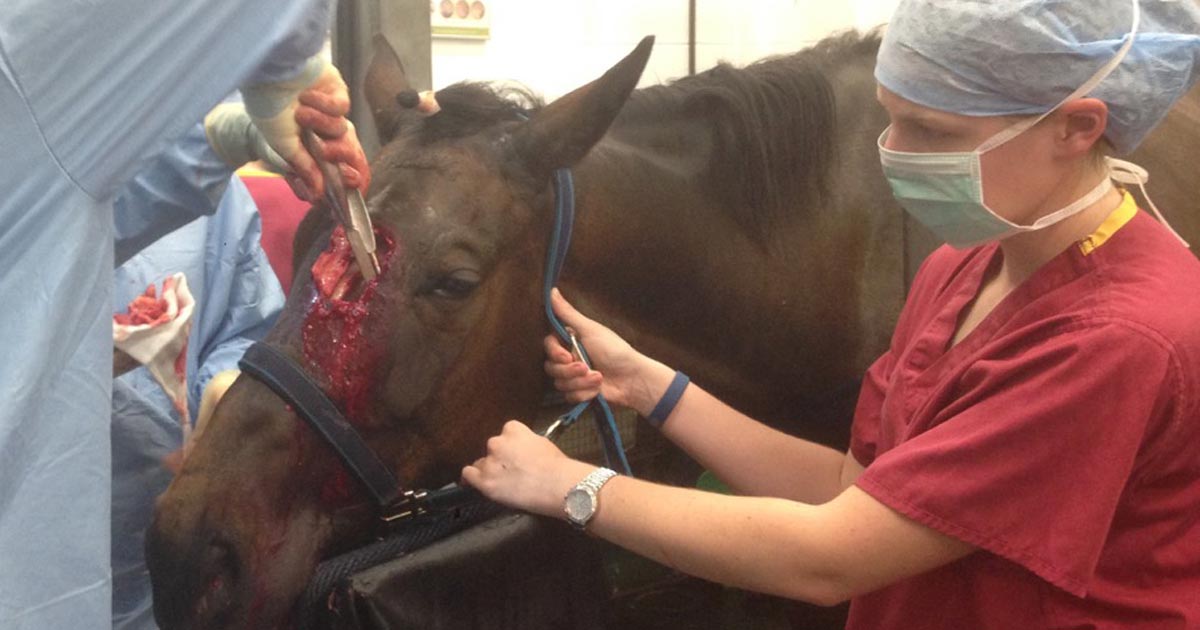On my latest EMS placement at an equine hospital, I’ve seen a number of surgeries – some done under general anaesthesia (GA) and others under standing sedation.
After getting over the fact a horse can stand half asleep while having its face drilled into and not really seem to care, I started wondering about the pros and cons of both approaches.

Generally, standing sedation is accompanied by less haemorrhage and, therefore, increased visibility – in sinus surgery, for example. It also eliminates many risks associated with general anaesthesia. However, asepsis may be harder to maintain (for example, if the horse moves and the surgical site comes into contact with something that isn’t sterile, such as the stocks).
Lower costs
For the client, procedures conducted under standing sedation would be much cheaper than the costs incurred from general anaesthesia.
During general anaesthesia, atelectasis contributes to the risks from an intraoperative point of view, as well as myositis and cardiac concerns (of which the risk can be considerably reduced by the use of acepromazine in the premedication protocol).
A risk of injury also exists during recovery and knockdown, such as worsening incomplete fractures or other self-inflicted wounds, which can, to some degree, be prevented by carefully assisted knockdown and paying careful attention during recovery with the use of ropes.
Achieving optimal sedation for standing surgery can, in some cases, be difficult. For example, the horse must be adequately sedated, but not so much it is swaying; this can be an issue for intricate surgeries, but may be more of a problem for diagnostic imaging (such as MRI or bone scintigraphy).
In these cases, I have seen morphine used – opposed to the usual sedative culprits, such as detomidine, butorphanol and xylazine – and it seems to achieve sedation without so much swaying.
Choosing correct method
The choice of standing sedation versus GA depends on the type of surgery required, but a number of procedures can be done using either method.
Last week, I saw tie-back surgeries (prosthetic laryngoplasties to correct laryngeal hemiplegia) done both ways, which made for an interesting comparison. The standing tie-back was considerably quicker, taking into account the time for knockdown and recovery, as well as surgical time.
Both tie-backs were followed by a laser hobday procedure (ventriculoectomy), meaning both procedures were conducted under the same sedation in the standing horse, whereas the tie-back performed after GA had to be followed later the same day, after the horse had recovered sufficiently to undergo standing sedation for the laser.
The second tie-back was a repeat of a previously failed procedure, hence GA was chosen to allow removal of the first prosthesis.
The standing technique is still being tweaked, but, despite reports of postoperative infection in more cases than ideal, the easier access to the laryngeal cartilages while standing – and the avoidance of further risks associated with GA – contribute to continued work to perfect this method.
Some surgeries, however, can still only be done properly via GA. Colic surgery, for example, requires significant abdominal access and, often, examination of the gastrointestinal tract. It is also highly recommended septic joint surgery and lavage is conducted under GA to ensure optimal sterility on closure of the joint.
Conclusion
Having now seen both types of surgery in the horse, it’s astonishing how quick standing surgery can be, and how much goes into the preparation and recovery for GA – even for the shortest of procedures. In one surgery, division of the aryepiglottic fold, causing epiglottic entrapment, took a matter of minutes – if you didn’t count the couple of hours total taken for premedication, knockdown and recovery from GA.
The choice very much depends on the procedure, and is assessed for each case. I do, however, think the advantages to standing surgery are significant and look forward to seeing more standing techniques developed in the future.

Leave a Reply